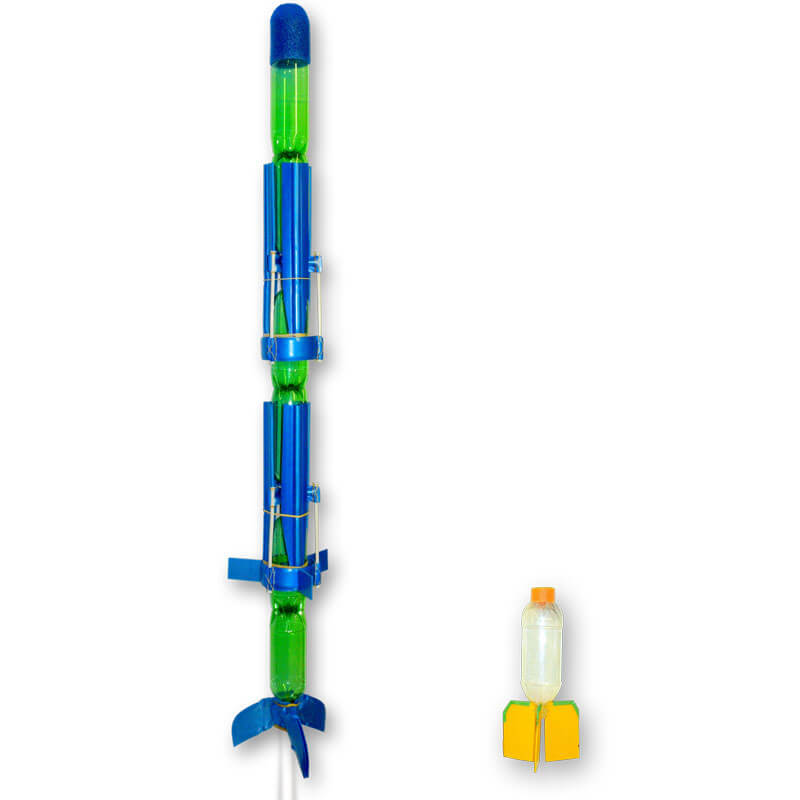Why Do We Show You How To Make Your Own Pop Bottle Rocket?
If you’re in a time pinch and need a Pop Bottle Rocket today, it’s nice to be able to get something impressive flying that’s easy to make, without having to wait for it to be delivered. We’re happy if the homemade rocket lessons on the website can help you.
Or if you are the self-determined creative type that has to build it yourself, we hope that the experience we’ve packaged into our homemade rocket lessons will be useful to you.
Plus, one of the best ways to appreciate the advanced ideas and engineering that have gone into AntiGravity’s line of water rockets is to build one yourself, from scratch.
At AntiGravity, it is our hope that once you have caught the rocket bug, your insatiable curiosity will make you want to see first-hand the strange and wonderful ideas that have gone into the rockets that we (AntiGravity) make! We want you to examine our ideas and introduce yourself to new, exciting ways of thinking about water rockets!
Aren’t All Pop Bottle Rockets the Same?
We at AntiGravity are sure you’ll find the homemade rocket exciting, impressive and safe. It is, however, in many ways, incompatible with our professional rockets and with our unique design philosophy. Here are some of the subtle and not-so-subtle differences!
Big Nozzle vs Small Nozzle
The homemade rocket uses the open neck of the bottle as its nozzle. The rocket goes pretty darn fast; too fast to be efficient. But it’s exciting and fun and impressive anyway.
AntiGravity rockets use a much smaller nozzle that is matched to the load that it is carrying. This slows the rocket down so you can see it accelerating upward. It also cuts down on the water rocket’s biggest enemy: air friction.
Glue vs Elastic Bands
The homemade rocket accelerates so fast that the fins have to be glued on to stay in place.
AntiGravity rockets accelerate gently, so the fins can be held on with very flexible elastic bands.
Heavy vs Light
The homemade rocket has to carry more water because of its big nozzle, so the fins have to be heavy and strong just to hold the extra weight up,
AntiGravity rockets only need 100 ml of water. That doesn’t weigh very much, so the fins can be light and flexible.
Fast vs Slow
The homemade rocket goes up really fast! If you blink you might not see it! And when you go up that fast, you have lots of air friction slowing you back down.
AntiGravity rockets go up much slower, with thrust that lasts almost all the way to the top of the flight. Slow is better if you are trying to cut down on air friction!
Cork vs Control
The homemade launcher uses a cork that gets pushed out whenever the pressure in the bottle is enough to push the cork out. This can be anywhere from 20 to 40 pounds per square inch. It works great! But you don’t have much control over it other than pumping it up.
AntiGravity rocket launchers use a bulb that holds on to the inside of the rocket nozzle as long as you are pumping up the rocket. You control the launch of the rocket by stopping pumping, or by opening the connector lever on the pump. And it can launch at 80 psi pressure!
Simple Rocket Only vs Extendable Design
The homemade rocket design is deliberately simple so that you can have a spectacular rocket experience without being a rocket scientist.
We’re quite sure that your curiosity will lead you to AntiGravity’s many different types of water rockets. The simple-but-advanced ideas remove the limits that keep other rockets back. Make sure to remove your own limits, and take a serious look at our professional line of water rockets!
